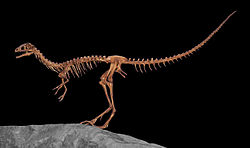Compsognathus
Compsognathus was a small carnivorous theropod dinosaur, from the end of the Jurassic period, around 144 million years ago. It was about a metre long, and ran on two legs, using its long tail to keep its balance.
| Compsognathus Temporal range: Upper Jurassic
| |
|---|---|

| |
| Compsognathus Oxford University Museum of Natural History note the narrow skull and long snout. | |
| Scientific classification | |
| Kingdom: | |
| Class: | |
| Superorder: | |
| Order: | |
| Suborder: | |
| (unranked): | |
| Family: | |
| Genus: | Compsognathus Wagner, 1859
|
| Species | |
|
C. longipes Wagner, 1859 (type) | |


Model sculpted by Bruce J. Mohn
Compsognathus is known from two nearly complete specimens, one from Germany (89 cm 35 in long), and another from France (125 cm 49 in long).[1] The German specimen was found in the Solnhofen limestone in Bavaria, over 150 years ago.
The larger French specimen (MNHN CNJ 79) was discovered in 1972 in the Portland limestone, near Nice in southeastern France. Although originally described as a separate species called Compsognathus corallestris,[2] others have since renamed it as another example of Compsognathus longipes.[3][4]
It is one of the few dinosaurs whose diet is known with certainty: the remains of small, agile lizards are preserved in the bellies of both specimens. Also it was once the smallest dino on earth but now that belongs to the Micropachycephalosaurus
Historical importance change
Thomas Henry Huxley ("Darwin's bulldog"), who was a comparative anatomist, made a study of it nearly 150 years ago. He compared the first fossil bird, Archaeopteryx, with Compsognathus. These two fossils were found in the same rocks: Solnhofen limestone in Bavaria, Germany. The strata come from the end of the Jurassic, about 144 million years ago. Huxley showed that the two were almost identical, except for the front limbs and feathers of Archaeopteryx. He showed the basic affinity of birds and reptiles, which he united them under the title of Sauropsida. Huxley concluded that birds evolved from small carnivorous dinosaurs.[5][6]
Diet change
The remains of a lizard in the German specimen's thoracic cavity show that Compsognathus preyed on small vertebrates.[7] Marsh, who examined the specimen in 1881, thought that this small skeleton inside Compsognathus belly was an embryo, but in 1903, Franz Nopcsa concluded that it was a lizard.[8] Ostrom identified the remains as belonging to a lizard of the genus Bavarisaurus,[9] which he concluded was a fast and agile runner owing to its long tail and limb proportions. This in turn led to the conclusion that its predators, Compsognathus, must have had sharp vision and the ability to rapidly accelerate and outrun the lizard.[10] The Bavarisaurus is in a single piece, indicating that the Compsognathus must have swallowed its prey whole. The French specimen's gastric contents consist of unidentified lizards or sphenodontids.[4]
Size change
Compsognathus was once thought to be the smallest dinosaur. However, if we assume the smaller specimen was a juvenile, then there are other slightly smaller species. The smallest dinosaur is probably Anchiornis; other candidates are: Micropachycephalosaurus; Caenagnathasia; Microraptor; and Parvicursor.
References change
- ↑ Paul, G.S. (1988). "Early Avetheropods". Predatory dinosaurs of the world. New York: Simon & Schuster. pp. 297–300. ISBN 0-671-61946-2.
- ↑ Bidar, A.; Demay, L.; Thomel, G. (1972). "Compsognathus corallestris, une nouvelle espèce de dinosaurien théropode du Portlandien de Canjuers (Sud-Est de la France)". Annales du Muséum d'Histoire Naturelle de Nice. 1: 9–40.
- ↑ Michard, J. G. (1991). "Description du Compsognathus (Saurischia, Theropoda) de Canjuers (Jurassique supérieur du Sud-est de la France), position phylogénétique, relation avec Archaeopteryx et implications sur l'origine théropodienne des oiseaux". Ph.D. Dissertation, Muséum National d'Histoire Naturelle, Paris.
- ↑ 4.0 4.1 Peyer, K. (2006). "A reconsideration of Compsognathus from the Upper Tithonian Of Canjuers, Southeastern France". Journal of Vertebrate Paleontology. 26 (4): 879–896. doi:10.1671/0272-4634(2006)26[879:AROCFT]2.0.CO;2. S2CID 86338296.
- ↑ Paul G. 2002. Dinosaurs of the Air, the evolution and loss of flight in dinosaurs and birds. p171–224 Johns Hopkins, Baltimore. ISBN 0-8018-6763-0
- ↑ Foster, Michael and Lankester, E. Ray (eds )1898–1903. The scientific memoirs of Thomas Henry Huxley. 4 vols and supplement, Macmillan, London ISBN 1432640119
- ↑ Chen, Pei-ji; Dong, Zhi-Ming; Zhen, Shuo-nan (1998). "An exceptionally well-preserved theropod dinosaur from the Yixian Formation of China" (PDF). Nature. 391 (6663): 147–152. Bibcode:1998Natur.391..147C. doi:10.1038/34356. S2CID 4430927.
- ↑ Nopcsa, Baron F. (1903). "Neues ueber Compsognathus". Neues Jahrbuch fur Mineralogie, Geologie und Palaeontologie (Stuttgart). 16: 476–494.
- ↑ Evans, S.E. (1994). "The Solnhofen (Jurassic: Tithonian) lizard genus Bavarisaurus: new skull material and a reinterpretation". Neues Jahrbuch für Paläontologie und Geologie, Abhandlungen. 192: 37–52.
- ↑ Ostrom, J.H. (1978). "The osteology of Compsognathus longipes". Zitteliana. 4: 73–118.